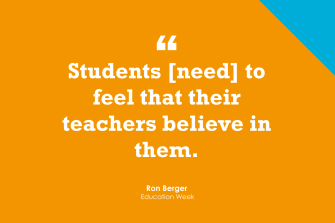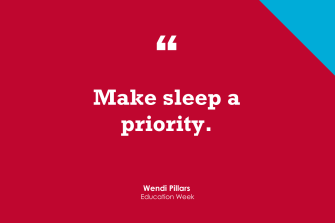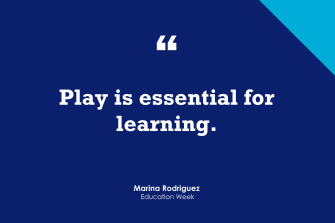So much research is done on education, and so much of it doesn’t get communicated to us teachers.
This multipart series will share various research findings that contributors feel educators should know.
Believing in Students
Ron Berger has over 45 years of experience in education, 28 of them as a public school teacher. He is the author of a collection of books on education, including and . He leads vision for teaching and learning:
I was discussing education with my friend Albert during a long run when he surprised me with a bold statement: “Well, there’s only one thing that matters about being a good teacher.” Having worked in education for almost 50 years, I told him with an amused smile that I had no idea what that one thing was.
Albert said: “The only thing that matters is that the teacher believes in you. And that they act on that.”
I asked him to say more.
He said, “I was a knucklehead of a student, making bad choices and being a wise guy. I did not come from an academic background. I was not wealthy; I was not white. None of my teachers thought I would amount to anything, and they showed that in how they treated me. In all my time in school, there were only two teachers who saw my potential and believed in me. They told me so and they pushed me and had high expectations for me. Now I’m about to get my Ph.D., and it’s all because of those two teachers.”
Most of us working in education believe that things are not that simple.
But there is much truth in what Albert said, and a body of compelling recent research makes that clear. A group of brilliant researchers, many of whom studied at Stanford with Carol Dweck’s mindset-focused team, continue to lead studies that make Albert’s statement seem profound. That group includes David Yeager, Greg Walton, Jason Okonofua, and Dave Paunesku.
I will describe just two studies here while encouraging readers to look into more work from these researchers.
In 2013, David Yeager and colleagues tested out the power of what simple written feedback that conveyed belief in students could achieve. In their words:
“7th-grade students wrote first drafts of a five-paragraph essay about their personal heroes. Next, teachers covered the essays with comments. Before the students got the comments, though, the research team attached hand-written notes from the teachers to the essays—either a “treatment” note or a “control” note. (Teachers wrote the notes, but they didn’t know which student got which note or what the study was trying to test.) Half the students were in the treatment group, which provided wise feedback.
The treatment note with the wise feedback said, “I’m giving you these comments because I have very high standards, and I know that you can meet them.” Half the students were in a control group that got a non-specific control note along the lines of, “I’m sharing these comments so you have feedback on your essay,” which conveyed no clear benevolent reason for the feedback. Teachers handed back the essays (in sealed folders so they couldn’t see who got which note). Then, students had a week to revise their essays.”
The results:
“Our study showed that students who got the wise feedback note were twice as likely to revise their essays as those who didn’t: 40% revised their essays in the control group, but 80% revised them in the treatment group. The next year, when we ran the study with new students in the same teachers’ classes, we required all students to revise their essays. We found that students made more than twice as many of the teachers’ suggested corrections (e.g., you need to put a comma here, explain this idea further, rearrange this sentence), from 2.2 in the control to 5.5 when they got the wise feedback treatment note. What’s more, we found more equitable outcomes. Although students benefited overall from wise feedback, those belonging to minority groups (in this case, Black students) benefited most, which eliminated racial disparities in their revisions.”
You can read the full study .
In 2021, Greg Walton, Jason Okonofua, and colleagues published a study about an intervention to help adjudicated youth—students who had been incarcerated—successfully reenter school.
In the researchers’ words:
“The intervention was simple to implement yet precisely designed, timed, and targeted. Students reflected on their values and goals in school and identified and introduced themselves to an educator with whom they wished to build a stronger relationship—all in a 45-minute to 60-minute one-on-one session a few days after reentering school. This educator then received the student’s self-introduction in a one-page letter from our team requesting their support.
Unlike past interventions, this approach focuses on students and educators simultaneously in an integrated manner. When reentering school, youths have already been told that they do not belong, stereotypes are palpably on the table, and trust has been broken. Even if students approach an educator with a positive mindset, they may not be well-received. Thus, we aimed to support (a) students’ belief in the value and possibility of cultivating positive relationships with educators as well as (b) educators’ receptiveness to those efforts. We targeted the relationship, not either person alone.”
The results:
“In a preliminary field trial (N = 47), presenting this self-introduction to this educator in a one-page letter via a third party requesting the educator’s help reduced recidivism to juvenile detention through the next semester from 69% to 29%. In Study 2, the letter led experienced teachers (N = 349) to express greater commitment to, anticipate more success for, and feel more love and respect for a student beginning their reentry into school …”
You can read the full paper
These studies, which piloted interventions to change the student-teacher relationship closer to Albert’s vision—a relationship where the student feels that a teacher believes in them—did not improve outcomes by a small percentage. In both cases, the increase was greater than 100 percent, more than doubling the positive effects.
“The only thing that matters is that the teacher believes in you. And that they act on that.”
Albert, who is now a professor and teacher himself, was not so far off in this bold statement. Many things matter in education, but perhaps none quite so much as the need for students to feel that their teachers believe in them and will honor them with high expectations and support.

Teachers Need to Sleep
Wendi Pillars, a national-board-certified teachers, has been teaching nearly three decades, both overseas and stateside, in grades K-12. She currently teaches biology and earth science and works with multilingual learners at the high school level. She is the author of . Connect with her on Twitter @wendi322:
As teachers, sleep often takes a backseat to our daily commitments, leaving us feeling exhausted and mentally drained, so it’s crucial to recognize how important sleep is for maintaining our physical, mental, and emotional well-being. Want to snooze your way to success? Check out these scientifically backed tips to optimize your sleep habits and know that most people hugely underestimate their need for sleep. Michael Roizen, the chief wellness officer of the Cleveland Clinic, says, “Sleep is our most underrated health habit.” A National Sleep Foundation report backs this up: Two-thirds of Americans are not getting enough sleep on weeknights.
Prioritize Sleep for Improved Performance
Sleep expert Matthew Walker, in his book emphasizes the essential role of sleep in memory consolidation and learning. For teachers, a well-rested mind is more receptive to new information and can deliver lessons with enhanced clarity. Prioritizing sleep helps us to retain and recall information effectively, which in turn, leads to our improved performance both in the classroom and beyond.
Embrace the Power of Naps (don’t laugh!)
Late night gate duty? A second job? Grading 100 papers? We teachers often find ourselves juggling multiple responsibilities, which can lead to sleep deficits. To combat this, follow the advice of Sara C. Mednick, a sleep researcher and the author of . She explains how a short power nap—even as little as six minutes(!!)—can enhance cognitive function, creativity, and productivity. Her research shows that “Learning after a nap is equal to learning after a full night of sleep.” Although not always possible, could you try to integrate a well-timed six-minute nap during the day knowing it could lead to a more engaging and effective teaching experience?
Create a Sleep-Inducing Environment
Shawn Stevenson, the author of emphasizes the importance of optimizing your bedroom environment for getting a restful night’s sleep. As teachers, we can benefit from dimming the lights, reducing noise, shunning TVs and screens, and maintaining a comfortable room temperature (65, ideally). I realize many of us have kids and challenging circumstances, so how much of this can you do within the constraints of your reality? What’s just one thing you could tweak knowing these factors help us wake up ready to face the challenges of the day?
Set a Consistent Sleep Schedule
Inconsistent sleep schedules disrupt our internal circadian rhythm, also leading to sleep deprivation. Michael Breus, known as “the sleep doctor,” advises setting a consistent sleep schedule, even on weekends since regular sleep and wake-up times help synchronize our body’s internal clock, promoting better sleep patterns and overall well-being. Remember that your day actually begins the night before!
Limit Screen Time Before Bed
Excessive screen time before bedtime has become a ubiquitous sleep disruptor. Drawing from Arianna Huffington’s research in her book teachers must recognize the impact of electronic devices on sleep quality. Blue light emitted by screens interferes with the production of melatonin, a hormone that regulates sleep. Establish a digital sunset before bedtime (start with 15 minutes, then make it longer, aiming for at least an hour with no screentime), to allow your mind to unwind naturally.
Your Overall Health Depends on Sleep
In 2015, experts from the American Academy of Sleep Medicine and the Sleep Research Society determined that a minimum of seven hours of sleep a night is essential for optimal health. Sleep deprivation has profound physiological consequences including hormone disruption, increased cortisol levels, impaired glucose metabolism, increased risk of obesity and diabetes, and a weakened immune system. Mentally, sleep deprivation impairs cognitive function, attention, and decisionmaking abilities. Teachers may experience difficulty processing information, leading to reduced teaching efficacy and especially patience. Emotionally, insufficient sleep can lead to mood swings, depression, irritability, and decreased emotional resilience, affecting our interactions with students and colleagues. We don’t need any of that!
Bonus Tip: Cortisol and Weight: The Sleep Connection
Lack of sleep also plays a significant role in weight management, with a crucial link between sleep deprivation, cortisol levels, and weight gain. Cortisol, aka, the “stress hormone,” is released in response to stressors, including sleep deprivation. When we don’t get enough sleep, our cortisol levels remain elevated, leading to increased feelings of stress and anxiety. Elevated cortisol levels in turn trigger cravings for high-calorie, sugary, and fatty foods.
Consequently, teachers who regularly experience sleep deprivation may find themselves reaching for unhealthy snacks to cope with fatigue and stress. Chronic sleep deprivation further disrupts the balance of hunger-regulating hormones, such as leptin and ghrelin, which leads to an increased appetite and reduced feelings of satiety. This combination of factors can contribute to weight gain over time. Prioritizing consistent sleep can help teachers regulate cortisol levels and hormonal balance to support weight-management goals.
An Obvious Conclusion
As educators, it’s a nonnegotiable to recognize quality sleep not as a luxury but as a necessity for thriving in our teacher roles with unique demands. Make sleep a priority. As we dial in our own seven hours of sleep, we can then model and teach these same ideas to our students to develop an incredibly engaged learning environment.

The Importance of Play
Marina Rodriguez is a 6th grade dual-language arts teacher at a Title I intermediate school in College Station, Texas. She has taught in a dual-language program for 17 years and is a former co-author of . She can be reached through her website, , or on Twitter :
One research finding I think teachers should know more about is the importance of play in the classroom. Students who participate in play gain a learning advantage. It’s the reason many teachers often integrate play into academic practice, but what exactly is play? What is the impact of play on students? How can we add more play to our learning environments?
What exactly is play?
There are many ways to define play. According to the American Academy of Pediatrics 2018 clinical report on play, “There is a growing consensus that it is an activity that is intrinsically motivated, entails active engagement, and results in joyful discovery.”
Play can be physical, intellectual, or social/emotional. It can be guided, unstructured, or a combination of both. Regardless of the descriptive variations, play is foundational for learning.
What is the impact of play on students?
Play directly impacts cognitive and psychological development. According to a 2016 analysis by Cambridge University psychology and education researcher David Whitebread, “Neuroscientific studies have shown that playful activity leads to synaptic growth, particularly in the frontal cortex, the part of the brain responsible for the uniquely human higher mental functions.”
The American Academy of Pediatrics issued a clinical report in 2018 that noted: “In the presence of childhood adversity, the role of play becomes even more important in that the mutual joy and shared attunement that parents and children can experience during play downregulates the body’s stress response. Hence, play may be an effective antidote to the changes in amygdala size, impulsivity, aggression, and uncontrolled emotion that result from significant childhood adversity and toxic stress.”
For multilingual students, play leads to trust, and trust leads to language acquisition. The invisible rule I’ve learned as a classroom teacher is that trust comes before learning. Play-based practices help establish trust by increasing levels of serotonin, dopamine, GABA, and other feel-good hormones, resulting in a reduction of stress and anxiety. Reductions in stress and anxiety help open a student’s affective filter for language acquisition, according to American linguist, educational researcher, and professor of education Stephen Krashen’s “affective filter hypothesis.”
Students who play experience an improvement in memory, attention, and concentration. They are more able to stay on-task, demonstrate less disruptive behavior, and improve their social and emotional development. Play can undoubtedly make a significant impact on students.
How can we add more play to our learning environments?
There are endless ways to bring play into the classroom. Below are a few ways play and learning can join classroom practice:
- Singing
- Number games
- Passion projects
- Hearing and telling stories
- Classroom discussions
- Any hands-on experiment or lesson led by the energy of a passionate teacher
We do not have to transform our classrooms into absolute play-based environments, but it is important to remember that adding a bit more play is not as hard as it might seem.
In Conclusion
The impact of play on memory, attention, concentration, and behavior is well-researched. The neurological stimulation that play creates in the brain is important for all ages, from early childhood to adulthood. While play is an important component of a healthy learning environment, it is usually the first to go when time is of the essence. The problem is that time is of the essence pretty much every single day in today’s classrooms.
The mental health issues exacerbated by the pandemic, ever-changing curriculum, and high-stakes testing leave little room for stressless spaces in the classroom. What remains of play is often minimal, placed into online platforms, or pushed into “if we have extra time” zones.
Play is essential for learning. The research is irrefutable. If we want students to thrive in school and in life, play must find a permanent place inside our classrooms.
References
Sahlberg, P. & Doyle, W. (2019). Let the Children Play. New York, NY: Oxford University Press
Freeman, D. & Freeman, Y. (2014). Essential Linguistics. Portsmouth, NH: Heinemann.

Thanks to Ron, Wendi, and Marina for contributing their thoughts!
Today’s post began a series answering this question:
What are one to three research findings that you think teachers should know about but that you also think that many of them do not?
Consider contributing a question to be answered in a future post. You can send one to me at lferlazzo@epe.org. When you send it in, let me know if I can use your real name if it’s selected or if you’d prefer remaining anonymous and have a pseudonym in mind.
You can also contact me on Twitter at .
Just a reminder; you can subscribe and receive updates from this blog via . And if you missed any of the highlights from the first 12 years of this blog, you can see a categorized list here.





